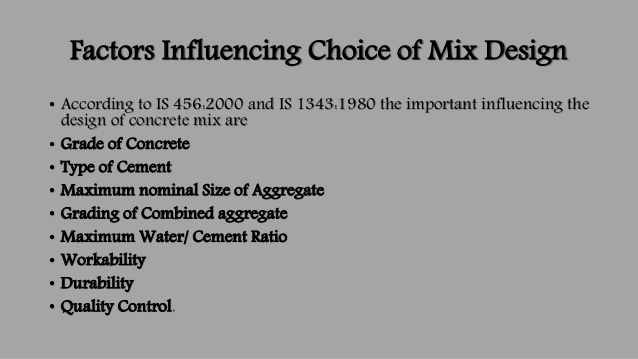Factors affecting mix design of concrete
As per IS 456:2000 and IS 1343:1980 codes, the design of concrete mix depends on the following factors :-
- Grade of concrete
- Type of cement
- Maximum nominal size of aggregate
- Grading of combined aggregate
- Maximum water cement ratio
- Workability
- Stability
- Qualify control
ALSO READ : HOW TO CALCULATE CEMENT SAND AND AGGREGATE QUANTITY IN CONCRETE
Grade of concrete
The grade of concrete provides characteristic compressive strength of concrete.
The grade M20 defines characteristic compressive strength fck of 20 N/m2. Based on the degree of control accessible at construction site, the concrete mix should be designed for a target mean compressive strength (fck) with the use of proper standard deviation.
Type of cement
The rate of development of concrete strength is dependent on the type of cement.
If the strength of cement applied in concrete becomes greater, the cement content will be lower. If 43 grade and 53 grade of cement are utilized, the intake of cement will be saved as much as 15% & 25% relatively with regard to 33 grade of cement. For concrete of grade M25, application of 43 and 53 grade of cement are recommended.
Maximum nominal size of aggregate
The maximum size of C.A is decided with sieve analysis. It is denoted by the sieve size greater than larger size on which 15% or more of the aggregate is maintained. The maximum nominal size of C.A. should not be in excess of one-forth of minimum thickness of the member.
For heavily reinforced concrete members similar to ribs of main beams, the nominal maximum size of the aggregate should normally be restrained to sum under the minimum clear distance among the main bars of 5 mm less the minimum cover to the reinforcement, whichever is lower.
The concrete workability rises with a surge in the maximum size of aggregate. But the lower size of aggregates offers greater surface area for bonding with mortar matrix to provide superior strength.
Grading of combined aggregates
The proportional ratio of the fine & coarse aggregate in a concrete mix is one of the crucial factors to impact the strength of concrete.
For thick concrete, it is necessary that the fine & coarse aggregate should graded perfectly. If the aggregate obtained from natural sources do not comply with the specified grading, the parting of two or more aggregate is required.
Maximum water/cement ratio
Abram's water cement ratio defines that for any specified condition of the test, the strength of a workability concrete mix is mainly based on water cement ratio. The compressive strength is increased when the water cement ratio is reduced.
Workability
Workability of fresh concrete describes the situation with which a concrete mixture is blended, transported, arranged, condensed and finished devoid of damaging segregation & bleeding.
Stability
Stability needs low water cement ratio. It is generally obtained by reducing the water demand at a specified cement content rather than raising the cement content.
Water demand can be reduced by controlling the aggregate grading and applying water reducing admixtures.

